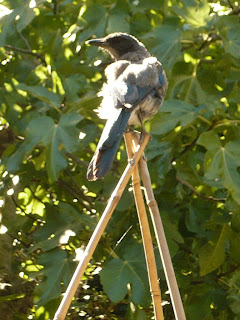There are three plants commonly referred to as "white man's footprint," though as a nickname it was probably applied to many more. The three plants are common plantain, common mullein, and Kentucky bluegrass. The adjective "white man's" should tip you that the term was coined by native Americans. These plants appeared where the land was damaged or disturbed - where the earth was tilled, where roads were being built, or where mine tailings were accumulated. They were the signature of agriculture and industry, and as such, the arrival of the white man.
Common plantain and common mullein are two of my favorite plants (or herbs, or weeds). In Idaho, where I grew up, they appear everywhere, though I've seen both in California. They both have broad leaves so are commonly referred to as "docks". Both have traditional medicinal uses.
Plantago majorThis is a low weed, about 10 inches at its tallest. The leaves are deep green and striated. Thin flower stalks originate from the center, topped like a Q-Tip with a one inch flower spike. The flowers on the spike bloom in sequence - a little burst of white satellites in an orbit perpendicular to the stalk.
I find something calming about this weed, either in its ubiquity or humility. It is known to be invasive, though I've had no luck incorporating it into my yard.
The English and American common names respectively: greater or common plantain
Vernacular names: waybread, cuckoo's bread, St Patrick's dock, snakeweed, snakebite, rat's tail
Verbascum thapsusAn impressive giant of a plant, mullein towers over a person. It starts with a low-growing, foot-wide tuft of velvety grey-green leaves, similar to lamb's ear. It then shoots up a massive spike decked the length with bright yellow flowers, similar to a hollyhock. The flowers resemble those of Hookers evening primrose.
The plant may be cultivated but draws insects so may better foraged.
The English and American common names respectively: greater or common mullein
Vernacular names: Jacob's (or Aaron's) rod, velvet dock, old man's blanket, hig candlewick, Bullicks lungwort, feltwort, and most colorfully, cowboy's toilet paper
The third plant known as "white man's footprint" is Kentucky bluegrass. Attempts are being made to replace this non-native grass with native grasses.
Also negatively associated with colonial encroachment is the "white man's fly," or the honeybee. These were imported to the America's in 1610, somehow surviving the six to eight week trip on ships to the Americas.
Philip Ackerman-Leist reminds us, in his book,
Up Tunket Road: The Education of a Modern Homesteader, that the appearance of the "white man's" legacy was seen as "...[harbinger] of the coming infiltration of a culture obsessed with domestication and, in many cases, dominion."









